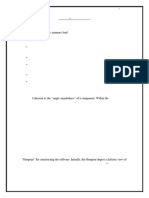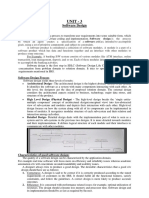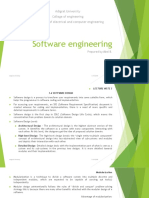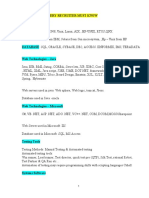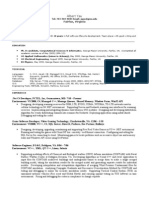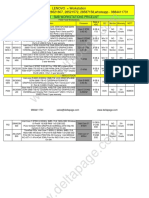0 ratings0% found this document useful (0 votes)
14 viewsUnitiii Partial
Unitiii Partial
Uploaded by
Rexline S JUNIT III Shared Information Systems – Database Integration –
Integration in Software Development Environments – Integration in the Design of Buildings – Architecture Structures for Shared Information Systems – Guidance for User-Interface Architectures.
Copyright:
© All Rights Reserved
Available Formats
Download as PPTX, PDF, TXT or read online from Scribd
Unitiii Partial
Unitiii Partial
Uploaded by
Rexline S J0 ratings0% found this document useful (0 votes)
14 views10 pagesUNIT III Shared Information Systems – Database Integration –
Integration in Software Development Environments – Integration in the Design of Buildings – Architecture Structures for Shared Information Systems – Guidance for User-Interface Architectures.
Copyright
© © All Rights Reserved
Available Formats
PPTX, PDF, TXT or read online from Scribd
Share this document
Did you find this document useful?
Is this content inappropriate?
UNIT III Shared Information Systems – Database Integration –
Integration in Software Development Environments – Integration in the Design of Buildings – Architecture Structures for Shared Information Systems – Guidance for User-Interface Architectures.
Copyright:
© All Rights Reserved
Available Formats
Download as PPTX, PDF, TXT or read online from Scribd
Download as pptx, pdf, or txt
0 ratings0% found this document useful (0 votes)
14 views10 pagesUnitiii Partial
Unitiii Partial
Uploaded by
Rexline S JUNIT III Shared Information Systems – Database Integration –
Integration in Software Development Environments – Integration in the Design of Buildings – Architecture Structures for Shared Information Systems – Guidance for User-Interface Architectures.
Copyright:
© All Rights Reserved
Available Formats
Download as PPTX, PDF, TXT or read online from Scribd
Download as pptx, pdf, or txt
You are on page 1of 10
SA_UNIT III _Partial II
Integration in Software Development
Environments
Software development has different requirements from database
processing. As compared to databases. software development involves
more different types of data, fewer instances of each distinct type, and
slower query rates. The units of information are larger, more complex,
and less discrete than in traditional databases.
Integration in Software Development
Environments
The earliest software development tools were standalone programs. Often
their output appeared only on paper and perhaps in the form of object code
on cards or paper tape.
New tools incorporated prior knowledge of related tools, and the usefulness of
shared information became more evident. Scripts grew up to invoke tools in
fixed orders. These scripts essentially defined batch sequential architectures.
Integration in Software Development
Environments
The ways that tools could interact with a shared repository.
Tight coupling: Share detailed knowledge of the common, but
proprietary, representation among the tools of a single vendor
Open representation: Publish the representation so that tools can
be developed by many sources. Often these tools can manipulate
the data, but they are in a poor position to change the
representation for their own needs.
Conversion boxes: Provide filters that import or export the data in
foreign representations. The tools usually lose the benefits of
incremental use of the repository.
No contact: Prevent a tool from using the repository, either
explicitly, through excess complexity, or through frequent changes.
Integration in Building Design
A project generally involves a number of independent,
geographically dispersed companies.
The diversity of expertise and dispersion of the industry inhibit
communication and limit the scope of responsibilities.
Each new project creates a new coalition, so there is little
accumulated shared experience and no special advantage for pair
wise compatibility between companies.
However, the subtasks interact in complex, sometimes non-obvious
ways, and coordination among specialties (global process expertise)
is itself a specialty.
Integration in Building Design
Integration includes,
construction community operates on divide-and-conquer problem
solving with interactions among the sub problems.
a large number of tasks in facility development depend on judgment,
experience, and rules of thumb accumulated by experts in the domain
involving standalone programs and batchsequential compositions
toward integration focused on support-supervisory systems, which
provided basic services such as data management and information flow
control to individual independent applications
Integrated environments for building design are frameworks
◦ efficient in managing problem-solving and information xchange
◦ flexible in dealing with changes to tools
◦ graceful in reacting to changes in information and problem solving
strategies
Architectural Structures for Shared
Information Systems
Current software tools, treat all modules equally, and they mostly
assume that modules interact only via procedure calls and perhaps
shared variables.
By providing only a single model of component, they tend to blind
designers to useful distinctions among modules.
The architectural descriptions focus on design issues such as the gross
structure of the system, the kinds of parts from which it is composed,
and the kinds of interactions that take place.
The use of well-known patterns leads to a kind of reuse of design
templates.
These templates capture intuitions that are a common part of our
folklore: it is now common practice to draw box-and-line diagrams that
depict the architecture of a system, but no uniform meaning is yet
associated with these diagrams.
Architectural Structures for Shared
Information Systems
Design Rules (Guidance) for User Interface
Systems
Stronger requirements for user interface adaptability across
devices favour higher levels of application interface abstraction, so
as to decouple the application from user interface details that may
change across devices. If the requirement is for global behaviour or
application semantics changes, then parameterized abstract devices
are also favoured.
High user customizability requirements favor external notations
for user interface behavior. Implicit and internal notations are
usually more difficult to access and more closely coupled to
application logic than are external notations.
Design Rules (Guidance) for User Interface
Systems
A high requirement for application portability across user
interface styles favours the higher levels of application interface
abstraction. Less obviously, it favours event-based or pure state-
based communication over the hybrid forms
If the maximum command execution time is short, a single thread
of control is practical and is favored as the simplest solution.
If external events must be handled, it is often worthwhile to
provide separate control thread(s) for this purpose. Separate
threads serve to decouple event handling logic from user interface
logic.
You might also like
- Integrative Programming and Technologies Chapter-1Document14 pagesIntegrative Programming and Technologies Chapter-1nigussie76% (21)
- Five9 Technical RequirementsDocument96 pagesFive9 Technical Requirementssandee1910No ratings yet
- Seminar Report On CSC 405Document24 pagesSeminar Report On CSC 405kaisarperson001No ratings yet
- Reviewer in INTEDocument6 pagesReviewer in INTEjanelpenaredondaNo ratings yet
- Unit 4 DesignDocument60 pagesUnit 4 DesignDhanshree GaikwadNo ratings yet
- Integrative Programming 1Document20 pagesIntegrative Programming 1itzvladimyr21No ratings yet
- Application System Are Used As The Basis of ApplicationsDocument7 pagesApplication System Are Used As The Basis of ApplicationsDuaFetaiNo ratings yet
- Report GuideDocument4 pagesReport GuideAdmin Asst. VINo ratings yet
- seq3Document5 pagesseq3shyam bkNo ratings yet
- SAD ShortQuestionsDocument6 pagesSAD ShortQuestionssukherafareedNo ratings yet
- Chapter 05Document78 pagesChapter 05ironpro224No ratings yet
- Herrmann Dan Mezini, 2013Document21 pagesHerrmann Dan Mezini, 2013RuslahNo ratings yet
- UNIT-3-Design Principles and Methodologies SEDocument9 pagesUNIT-3-Design Principles and Methodologies SErashiiiiicNo ratings yet
- SE Unit-3Document27 pagesSE Unit-3kunal kalraNo ratings yet
- Software Engineering: Adigrat University College of Engineering Department of Electrical and Computer EngineeringDocument29 pagesSoftware Engineering: Adigrat University College of Engineering Department of Electrical and Computer Engineeringzekarias amsaluNo ratings yet
- Unit 5 Cs701Document7 pagesUnit 5 Cs701monalisahooNo ratings yet
- Happy AiDocument25 pagesHappy Aianandita chalamalasettiNo ratings yet
- Chapter 1: Introduction To Integrative Programming & TechnologiesDocument9 pagesChapter 1: Introduction To Integrative Programming & TechnologiesAngelyn BlanquiscoNo ratings yet
- Mediator: An Intelligent Information System The Virtual Manufacturing EnterDocument6 pagesMediator: An Intelligent Information System The Virtual Manufacturing EnterirfansjiNo ratings yet
- Architectural Design SEDocument11 pagesArchitectural Design SEfernando shelaNo ratings yet
- Chapter 1 IntroductionDocument7 pagesChapter 1 IntroductionloanaiveannafayNo ratings yet
- Com 310 Cat 1Document6 pagesCom 310 Cat 1k41505915No ratings yet
- Unit 2Document27 pagesUnit 2mukul.money2003No ratings yet
- Software Engineering Unit 3 .......... 26-July-2021Document81 pagesSoftware Engineering Unit 3 .......... 26-July-2021project group 87No ratings yet
- Principles of A Good ArchitectureDocument6 pagesPrinciples of A Good ArchitectureminarviNo ratings yet
- EXAM 3 Study Guide AnswersDocument7 pagesEXAM 3 Study Guide AnswersjannaNo ratings yet
- Unit-3Document100 pagesUnit-321cse120 tankalareshmaNo ratings yet
- Shasha GreyDocument28 pagesShasha GreyFahad SiddiquiNo ratings yet
- Reference NotesDocument3 pagesReference Notesnewmovies1638No ratings yet
- Software Framework - Wikipedia, The Free EncyclopediaDocument4 pagesSoftware Framework - Wikipedia, The Free EncyclopediaRabin KoiralaNo ratings yet
- Unit 5 - Software ArchitectureDocument6 pagesUnit 5 - Software ArchitectureLucky KanatheNo ratings yet
- L1 - Inter-Systems CommunicationDocument42 pagesL1 - Inter-Systems CommunicationAaron Jude Pael100% (3)
- Software EngineeringDocument44 pagesSoftware EngineeringthalivathamilNo ratings yet
- A R S A: Eview On Oftware RchitectureDocument3 pagesA R S A: Eview On Oftware Rchitecturejaja jajaNo ratings yet
- Software Eng AnsDocument5 pagesSoftware Eng AnsgurugabruNo ratings yet
- Ygo Sakamoto - Low Hanging Software ArchitecturesDocument15 pagesYgo Sakamoto - Low Hanging Software ArchitecturesGlauco LemeNo ratings yet
- Software Engg. (Unit-3)Document21 pagesSoftware Engg. (Unit-3)Arin JainNo ratings yet
- Benefits of The Multi TierDocument5 pagesBenefits of The Multi TierJean-PaulNo ratings yet
- Tutorial No.7Document7 pagesTutorial No.7Pallavi BhartiNo ratings yet
- unit III-SEDocument33 pagesunit III-SESRI 2005No ratings yet
- pdf oneDocument12 pagespdf onekkdsam2No ratings yet
- MIT 820 Architectures For Software Systems and EmergingDocument26 pagesMIT 820 Architectures For Software Systems and EmergingEnson KYNo ratings yet
- Unit 5 MaterialDocument17 pagesUnit 5 Materialb628234No ratings yet
- unit-III sefor aiDocument26 pagesunit-III sefor aiuma maheshwariNo ratings yet
- Ch01 Overview of OOSDDocument5 pagesCh01 Overview of OOSDAmritaRupini100% (1)
- Unit 3 Architec StyleDocument6 pagesUnit 3 Architec StyleramyaprojectNo ratings yet
- Software Engineering Unit-3 - 1Document11 pagesSoftware Engineering Unit-3 - 1Elite gang subhamNo ratings yet
- Unit 2Document20 pagesUnit 2Armaan ArmaanNo ratings yet
- Design and ArchitectureDocument9 pagesDesign and ArchitectureIjazul HaqNo ratings yet
- Unit 3Document21 pagesUnit 3rkrahmat7890No ratings yet
- Software DesignDocument15 pagesSoftware Designanusha anuuNo ratings yet
- seDocument5 pagesseArjun BansalNo ratings yet
- Week 11Document47 pagesWeek 11ahmedkingdom774No ratings yet
- 4e4b PDFDocument13 pages4e4b PDFmamaNo ratings yet
- System Integration: Case Study of An Airport Information SystemDocument9 pagesSystem Integration: Case Study of An Airport Information Systemng28No ratings yet
- SE- Software DesignDocument99 pagesSE- Software DesignEyob TemesgenNo ratings yet
- Integration ModelsDocument11 pagesIntegration ModelsDivine ManaloNo ratings yet
- Unit 5 - SoftwareDocument8 pagesUnit 5 - SoftwareAbhay GuptaNo ratings yet
- Sa-Unit 1 NotesDocument15 pagesSa-Unit 1 NotesjoshuaNo ratings yet
- Unit 2Document10 pagesUnit 2tanujareddy2112No ratings yet
- Binary CountersDocument48 pagesBinary CountersRexline S JNo ratings yet
- Digital CircuitsDocument16 pagesDigital CircuitsRexline S JNo ratings yet
- Digital Circuits - DecodersDocument26 pagesDigital Circuits - DecodersRexline S JNo ratings yet
- DAA CodeDocument58 pagesDAA CodeRexline S JNo ratings yet
- DS UnitIIDocument57 pagesDS UnitIIRexline S JNo ratings yet
- Queue OperationsDocument19 pagesQueue OperationsRexline S JNo ratings yet
- Excitation TableDocument6 pagesExcitation TableRexline S JNo ratings yet
- Linux 1Document49 pagesLinux 1Rexline S JNo ratings yet
- Unit Iii - DS - PPTDocument71 pagesUnit Iii - DS - PPTRexline S JNo ratings yet
- UnitV DS PPTDocument58 pagesUnitV DS PPTRexline S JNo ratings yet
- DS UnitIDocument59 pagesDS UnitIRexline S JNo ratings yet
- Unit Iv - DS - PPTDocument60 pagesUnit Iv - DS - PPTRexline S JNo ratings yet
- Process SynchronizationDocument7 pagesProcess SynchronizationRexline S JNo ratings yet
- Os IntroDocument20 pagesOs IntroRexline S JNo ratings yet
- OS StructureDocument14 pagesOS StructureRexline S JNo ratings yet
- OS ServicesDocument11 pagesOS ServicesRexline S JNo ratings yet
- Unitiv PartialDocument52 pagesUnitiv PartialRexline S JNo ratings yet
- SA UnitIIDocument24 pagesSA UnitIIRexline S JNo ratings yet
- SA UnitII Case StudiesDocument20 pagesSA UnitII Case StudiesRexline S JNo ratings yet
- UNITVDocument34 pagesUNITVRexline S JNo ratings yet
- SA UnitIDocument55 pagesSA UnitIRexline S JNo ratings yet
- A MicroprocessorDocument13 pagesA MicroprocessorAbhimanyu GoyalNo ratings yet
- DA-70156 Manual English Rev2-0Document23 pagesDA-70156 Manual English Rev2-0quartetsNo ratings yet
- How To Process The PET/CT Data On Your Own PC: (Quick Manual)Document4 pagesHow To Process The PET/CT Data On Your Own PC: (Quick Manual)Physicien HopitalNo ratings yet
- Aamir Mirza: Personal DetailsDocument3 pagesAamir Mirza: Personal DetailsJunaid KhanNo ratings yet
- P Inputs To M Outputs in A Non-Blocking: Network Topology Advantages and Disadvantages Bus Based NetworkDocument8 pagesP Inputs To M Outputs in A Non-Blocking: Network Topology Advantages and Disadvantages Bus Based Networkالملاك الابيضNo ratings yet
- IT T33-Data Structures: SMVEC - Department of Information Technology 1Document14 pagesIT T33-Data Structures: SMVEC - Department of Information Technology 1Mathiazhagan ArumugamNo ratings yet
- Basic Technology ManualDocument33 pagesBasic Technology ManualSushil KumarNo ratings yet
- Albert YauDocument2 pagesAlbert YausurendradevycsNo ratings yet
- 8860 IP Configuration With BootP ServiceDocument7 pages8860 IP Configuration With BootP ServiceMingyiNo ratings yet
- GCC Lab Manual2Document50 pagesGCC Lab Manual2arungladstonNo ratings yet
- Mock Exam 3 AnswersDocument25 pagesMock Exam 3 Answersaina15febNo ratings yet
- Action Script Access To XMPDocument16 pagesAction Script Access To XMPTheo JagerNo ratings yet
- Gemini GV6K Quick ReferenceDocument2 pagesGemini GV6K Quick ReferenceairgoNo ratings yet
- RayCasting in DirectXDocument10 pagesRayCasting in DirectXsilly_rabbitzNo ratings yet
- Open Learning Book CadDocument348 pagesOpen Learning Book CadLoughton Bty100% (1)
- LogDocument22 pagesLogmohmad bhanNo ratings yet
- Algorithmic Problem Solving With Python: John B. Schneider Shira Lynn Broschat Jess Dahmen February 22, 2019Document6 pagesAlgorithmic Problem Solving With Python: John B. Schneider Shira Lynn Broschat Jess Dahmen February 22, 2019Video CreatorNo ratings yet
- Indesign Cs5 Automation Using XML Javascript CompressDocument491 pagesIndesign Cs5 Automation Using XML Javascript CompressBalageeonNo ratings yet
- Labo MSP430 2 3Document13 pagesLabo MSP430 2 3sreekanth2728No ratings yet
- ESP2866 WiFi Relay ModuleDocument10 pagesESP2866 WiFi Relay ModuleichNo ratings yet
- Drop BoxDocument179 pagesDrop Boxelgrillado2No ratings yet
- ICT PPTDocument4 pagesICT PPTayanaser6153563No ratings yet
- J2EE FAQ CollectionDocument115 pagesJ2EE FAQ CollectionPallab DattaNo ratings yet
- Admin Requirement MatrixDocument5 pagesAdmin Requirement Matrixgaddipati_ramuNo ratings yet
- AFUDOSDocument8 pagesAFUDOSKiotr81 pcsalaNo ratings yet
- Design of Smart Cane With Integrated Camera Module For Visually Impaired PeopleDocument7 pagesDesign of Smart Cane With Integrated Camera Module For Visually Impaired PeopleIJRASETPublicationsNo ratings yet
- ServerDocument13 pagesServerRamesh BabuNo ratings yet
- Simulation and Scientific Computing 2 Seminar: Kristina Pickl, Dominik Bartuschat SS 2012 Chair For System SimulationDocument60 pagesSimulation and Scientific Computing 2 Seminar: Kristina Pickl, Dominik Bartuschat SS 2012 Chair For System SimulationKhan Raqib MahmudNo ratings yet
- Carman Scan Lite PC Scan: User's GuideDocument48 pagesCarman Scan Lite PC Scan: User's GuideJose Luis Rodriguez CruzNo ratings yet








